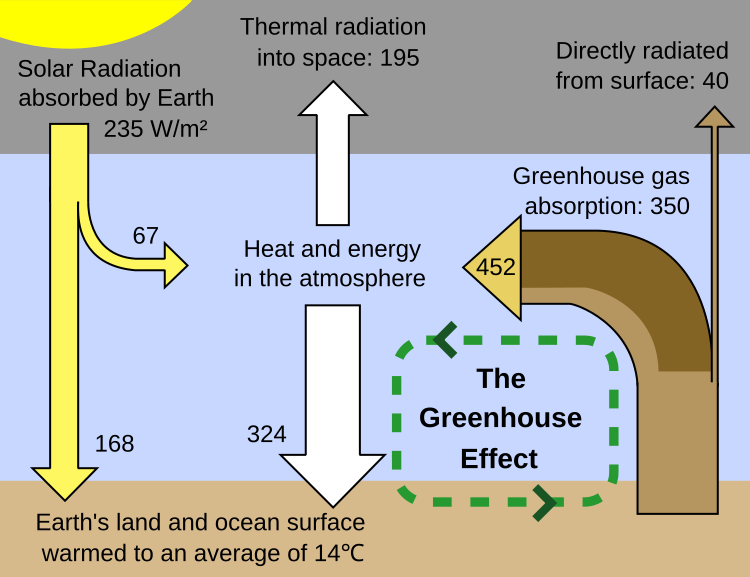파일:Greenhouse Effect.svg

SVG 파일의 PNG 형식의 미리보기 크기: 750 × 577 픽셀. 다른 해상도: 312 × 240 픽셀 | 624 × 480 픽셀 | 998 × 768 픽셀 | 1,280 × 985 픽셀 | 2,560 × 1,969 픽셀
원본 파일 (SVG 파일, 실제 크기 750 × 577 픽셀, 파일 크기: 21 KB)
파일 역사
날짜/시간 링크를 클릭하면 해당 시간의 파일을 볼 수 있습니다.
| 날짜/시간 | 섬네일 | 크기 | 사용자 | 설명 | |
|---|---|---|---|---|---|
| 현재 | 2021년 9월 1일 (수) 05:04 |  | 750 × 577 (21 KB) | Dragons flight | Revert to earlier version. Change is technically inaccurate. Energy flow balance requires that all forms of energy transfer are included, i.e. the land->atmosphere flow includes not only radiation but also conduction, convection, etc. Also, "heat radiation" appears to be colloquial. |
| 2021년 8월 23일 (월) 06:35 |  | 750 × 577 (21 KB) | Efbrazil | All heat radiation is now the same color, it is not clear why that was not the case before | |
| 2021년 8월 23일 (월) 05:31 |  | 750 × 577 (21 KB) | Efbrazil | A few text changes to make things more clear | |
| 2020년 4월 10일 (금) 02:42 |  | 750 × 577 (21 KB) | Efbrazil | Minor edit, improving alignment of text with larger font for thumbnail view | |
| 2020년 3월 31일 (화) 02:06 |  | 750 × 577 (21 KB) | Efbrazil | Improved fonts and alignment for thumbnail legibility | |
| 2007년 10월 26일 (금) 00:00 |  | 750 × 577 (21 KB) | Rugby471 | changed width | |
| 2007년 10월 3일 (수) 02:42 |  | 750 × 577 (20 KB) | Rugby471 | == Description == {{en|This figure is a simplified, schematic representation of the flows of energy between space, the atmosphere, and the Earth's surface, and shows how these flows combine to trap heat near the surface and |
이 파일을 사용하는 문서
이 파일을 사용하는 문서가 없습니다.
































